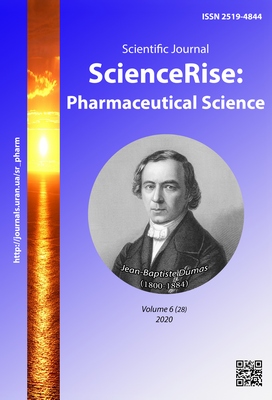Methods of assessment of quality of partnership relations between pharmaceutical market entities in the medicine promotion system on the basis of multicriterial choice
DOI:
https://doi.org/10.15587/2519-4852.2020.222252Keywords:
partnerships, pharmaceutical market players, promotion, medicines, “decision tree” modelAbstract
The aim. Development of a conceptual model for the formation of strategic partnerships between the subjects of the pharmaceutical market and the effectiveness of their management; development and testing of methods for assessing the quality of partnerships between pharmaceutical market participants in the system of promotion of medicines based on multi-criteria selection.
Materials and methods. Methods of content analysis, logical analysis, grouping, generalization, marketing research, statistical analysis, graphical method and “classification tree” (CART) method were used to implement the outlined research tasks.
Research results. The conceptual model of formation of strategic partnership relations (PR) and efficiency of their management between subjects of the pharmaceutical market (SPM) in system of advancement of medicines (drugs) in the pharmaceutical market is developed, the implementation of which will facilitate the integration of efforts to provide quality pharmaceutical care to the population of Ukraine. According to the expert survey, the importance of the criteria for evaluating SPM partnerships is determined: the duration of the relationship, the depth of the partnership, the possibility of duplication, the reliability and dynamics of the partnership, the effectiveness of the partnership. A method for assessing the quality of PR between SPM in the system of drug promotion based on multicriteria selection using the method of “decision tree”, which was tested in the practice of the studied pharmaceutical company (PC) in promoting the pharmaceutical enzyme complex to restore spine and joint function. PR quality assessment between SPM in the pharmaceutical product promotion system according to the developed algorithm is done by sequential comparison of predictors-criteria with the threshold values of their scores, according to which the descent along certain tree branches is reached until a terminal node corresponding to a certain the value (high, medium or low) of the level of quality of the relationship with the partner in the promotion of goods. The overall accuracy of the constructed algorithm is 80.2 %. Combinations of values of evaluation of partnership criteria which provide high, average and low level of quality of PR are defined.
Conclusions. The obtained results allowed to determine the group of the most optimal partners of the studied PC, which provide effective promotion of the pharmaceutical product on the basis of a high level of PR quality. The developed methodology for assessing the quality of PR between SPM in the system of pharmaceutical promotion based on multi-criteria selection will be useful for SPM who seek to develop and maintain long-term relationships with partners for consolidated cooperation by optimizing marketing activities. The results obtained are of practical importance and can be useful for SPM in order to form an effective and lasting partnership in the field of drug promotion, which will help improve the quality of pharmaceutical care and the availability of drugs for the population
References
- Kuzmin, O. E. (2010). Trust as economic category. Bulletin of NLTU of Ukraine, 20.2, 100–104.
- Mandibura, V. O. (2010). Restoration of trust of final consumption as a component of social responsibility of business. Theoretical and applied issues of economics, 21, 55–68.
- Matviishin, E. G., Matviishin, I. L. (2010). Assessment of factors of trust development as a basis for socio-economic growth in the regions of Ukraine. Public administration: theory and practice, 3-4, 230–235.
- Knyazyk, Y. M. (2010). The relationship of the subjects of marketing partnerships. Bulletin of Lviv Polytechnic National University, 690, 321–326.
- Us, M. I. (2011). Modern directions of partnership formation. Business Inform, 8, 181–183.
- Pidgurska, I. (2010). Features of the formation of international partnerships in the modern world economy. Galician Economic Bulletin, 1 (26), 5–11.
- Piven, E. P., Tkachenko, K. E., Tkachenko, I. V. (2015). Assessment of the level of awareness of specialists of pharmaceutical companies about the basic principles of relationship marketing. Management and marketing in the modern economy, science, education, practice. Kharkiv: NUPh, 218–221.
- Kotvitska, A. A., Bardakova, L. V. (2016). Research of the system of the state regulation of pharmaceutical legal relationship in the sphere of circulation of medicine. The scientific heritage, 6 (6), 140–143.
- Posylkina, O. V., Gorbunova, O. Y. (2009). The urgency of establishing a system of partnerships in the logistics chain of a pharmaceutical company. Bulletin of the Donetsk Institute of Road Transport, 1, 242–245.
- Posylkina, O. V., Gorbunova, O. Y. (2010). Diagnosis of the potential for the development of partnerships in the logistics pharmaceutical chain. Kharkiv: NUPh, 27.
- Olkhovska A. B., Malyi V. V. (2019). Formation of partnership relations between subjects of the pharmaceutical market in promotion of medicines in Ukraine and foreign countries. Social Pharmacy in Health Care, 5 (1), 31–40. doi: http://doi.org/10.24959/sphhcj.19.146
- Qabbaah, H., Sammour, G., Vanhoof, K. (2015). Decision Tree Analysis To Improve E-Mail Marketing Campaigns. Information Theories and Applications, 26 (1), 3–36.
- Hendalianpour, A., Razmi, J., Rameshi Sarvestani, A. (2016). Applying decision tree models to SMEs: A statistics-based model for customer relationship management. Management Science Letters, 6, 509–520. doi: http://doi.org/10.5267/j.msl.2016.5.002
- Olkhovska, A. B. (2019). Theoretical and scientific-applied principles of improving marketing communications in the system of promotion of drugs in Ukraine. Kharkiv, 44.
Downloads
Published
How to Cite
Issue
Section
License
Copyright (c) 2020 Anzhela Olkhovska, Volodymyr Malyi, Maryna Nessonova, Anna Chehrynets

This work is licensed under a Creative Commons Attribution 4.0 International License.
Our journal abides by the Creative Commons CC BY copyright rights and permissions for open access journals.








